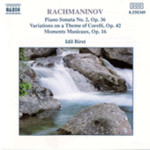
Rachmaninov: Piano Sonata No. 2 in B-Flat Minor / Variations on a Theme of Corelli / Moments Musicaux, Op. 16
 $25.00
Out of Stock
$25.00
Out of Stock6+ weeks add to cart
SERGEI RACHMANINOV
Rachmaninov: Piano Sonata No. 2 in B-Flat Minor / Variations on a Theme of Corelli / Moments Musicaux, Op. 16
Idil Biret (piano)
[ Naxos / CD ]
Release Date: Thursday 6 June 1991
This item is currently out of stock. It may take 6 or more weeks to obtain from when you place your order as this is a specialist product.
Rachmaninov left Russia in 1917. From then until his death in Beverly Hills in 1943, he was obliged to rely largely on performance for a living. Now there was very much less time for composition, as he undertook demanding concert tours, during which he dazzled audiences in Europe and America with his remarkable powers as a pianist. His house at Ivanovka was destroyed in the Russian civil war, and in 1931, the year of the Corelli Variations, his music was banned in Russia, to be permitted once more two years later. He spent much time in America, where there were lucrative concert tours, but established a music publishing house in Paris and built for himself a villa near Lucerne, where he completed his Paganini Rhapsody in 1934 and his Third Symphony a year later. In 1939 he left Europe to spend his final years in the United States.
Rachmaninov wrote the first of his two piano sonatas in 1907. The Second Piano Sonata, Opus 36, was completed in its first version in 1913 during a summer spent at Ivanovka, while he worked also on the orchestration of his large scale choral work, The Bells, that he had started in Rome earlier in the year, intending it for performance in Sheffield, an event prevented by the outbreak of war. The sonata was revised and abridged in 1931, when the composer cut some 120 bars from the work and rewrote and simplified some passages. The sonata, in the key of B flat minor, offers a stormy first subject, and a gentler second in a dotted rhythm that had assumed importance in the Opus 32 Preludes. A brief linking passage introduces a central slow movement, integrated into the whole structure, and similarly linked to a final stormy Allegro molto in B flat major.